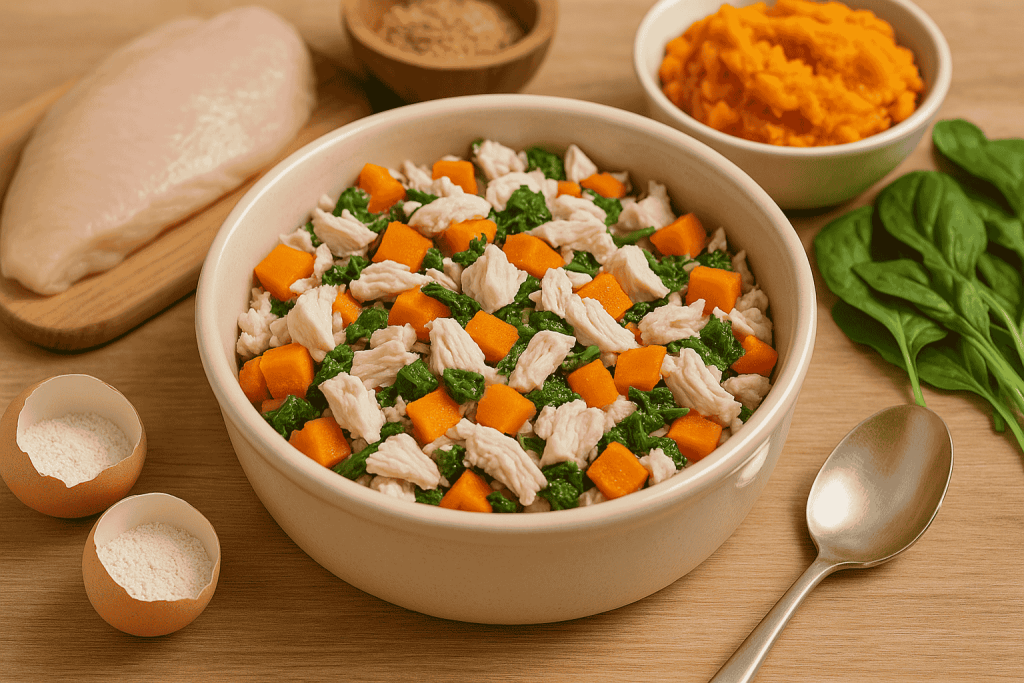Understanding Food Allergies in Dogs
Dog food allergies happen when your pup’s immune system overreacts to specific proteins or ingredients. Unlike food intolerances (which are digestive), allergies involve immune responses, often causing skin irritation, itching, ear infections, or chronic digestive upset.
According to PetMD, the most common allergens include beef, chicken, dairy, and wheat — ingredients found in many commercial dog foods.

Why Homemade Food Works for Allergies
Making food at home gives you full control over every ingredient — no mystery meats, fillers, or additives. It’s also easier to run elimination diets and identify specific triggers when you’re the chef.
Real story: My dog, Bear, had chronic ear infections and was constantly chewing his paws. We spent months cycling through premium dog foods with no success. It wasn’t until I switched to a homemade, limited-ingredient diet that the symptoms started to clear up. Today, we keep it simple, nutritious, and allergy-free — and he’s thriving.
At Fluffze, we advocate for mindful feeding, especially when allergies are involved. But it must be done correctly — and safely.
Signs Your Dog Might Have a Food Allergy
Watch for these common symptoms:
Itchy skin (especially feet, face, ears, belly)
Chronic ear infections
Red, inflamed skin or rashes
Vomiting or diarrhea
Gas and bloating
Excessive licking or paw chewing
Always consult your vet to rule out environmental or flea allergies first. A food trial may be needed to confirm food-related reactions.
Ingredients to Avoid (Common Allergens)
When crafting homemade meals, eliminate known culprits:
Ingredient Common Issue
Beef High allergen in many dogs
Chicken Especially common in kibble
Wheat/Gluten Linked to skin flare-ups
Dairy Causes gas or loose stools
Corn/Soy Can trigger digestive upset
Instead, use novel proteins like turkey, duck, lamb, or fish and gluten-free grains like brown rice or quinoa.
Vet-Approved Homemade Recipes for Allergic Dogs
Recipe 1: Turkey & Quinoa Bowl
Ingredients:
1 lb ground turkey
1 cup cooked quinoa
½ cup shredded zucchini
½ cup chopped spinach
1 tbsp olive oil
Instructions:
Brown turkey in a pan (no seasoning)
Add vegetables and cook until soft
Stir in cooked quinoa and olive oil
Cool before serving
Recipe 2: Salmon & Sweet Potato Stew
Ingredients:
1 cup cooked salmon (boneless)
1 cup mashed sweet potato
¼ cup chopped carrots
¼ cup green peas
1 tsp fish oil
Instructions:
Combine ingredients in a pot with ½ cup water
Simmer for 10–12 minutes
Mash to desired consistency
Let cool and portion into containers
How to Transition Safely to Homemade Food
Switching diets too fast can upset your dog’s stomach. Use the 7-day rule:
Day 1–2: 25% homemade, 75% old food
Day 3–4: 50/50
Day 5–6: 75% homemade
Day 7: Full homemade diet
Watch for changes in stool, energy, and itching. Any major issues? Pause and talk to your vet.
Nutritional Balance: Don’t Skip This Step
Homemade doesn’t mean healthier unless it’s balanced.
Dogs require the right proportions of:
Protein
Carbs
Fats
Vitamins (A, D, E, B-complex)
Minerals (calcium, zinc, etc.)
Use a tool like BalanceIT or consult a veterinary nutritionist to customize recipes. Never rely only on online recipes unless they’re vet-approved.
Some pet parents add:
Crushed eggshells for calcium
Fish oil for omega-3s
Pumpkin puree for digestion
Storing and Serving Homemade Dog Food
Store portions in airtight containers in the fridge (up to 3 days)
Freeze extra portions for up to 2 months
Reheat gently or serve at room temp (never hot)
Use glass or BPA-free containers for safety
Label batches by date and recipe for easy tracking.
FAQ: Homemade Dog Food for Allergies
Q1: How do I know if homemade food is helping my dog’s allergies?
Track symptoms over 2–4 weeks. If itching, ear infections, or stool issues improve, you’re on the right path.
Q2: Can I feed homemade food long-term?
Yes, but only if it’s balanced. Use vet-approved recipes and include all essential nutrients.
Q3: Is it cheaper than commercial allergy food?
Often yes — especially with bulk shopping and meal prep. You also avoid vet visits from flare-ups.
Q4: Can puppies eat homemade food?
Yes, but they require different nutrition ratios. Ask your vet or use a formulation tool designed for puppies.
Q5: How do I find out what ingredient my dog is allergic to?
Run an elimination diet (with vet help). Feed one protein and one carb source for 6–8 weeks, then reintroduce foods slowly.
Final Thoughts
Homemade dog food can be a game-changer for pups with allergies — but it has to be done right. Don’t guess. Choose simple, limited ingredients, watch your dog’s reactions, and always consult a vet or nutritionist to fine-tune the diet.
At Fluffze.com, we believe pet nutrition doesn’t have to be complicated. Just honest, intentional, and tailored to your dog’s needs.
Call to Action
If you found this guide helpful, share it with other dog parents dealing with food allergies.
And don’t miss our upcoming post on homemade cat food recipes for sensitive stomachs.
Author Box
Written by Shawn, pet lover & contributor at Fluffze
A lifelong dog dad and recipe tester, Shawn has helped hundreds of pet parents transition to allergy-friendly diets with real results and vet-reviewed guidance.
